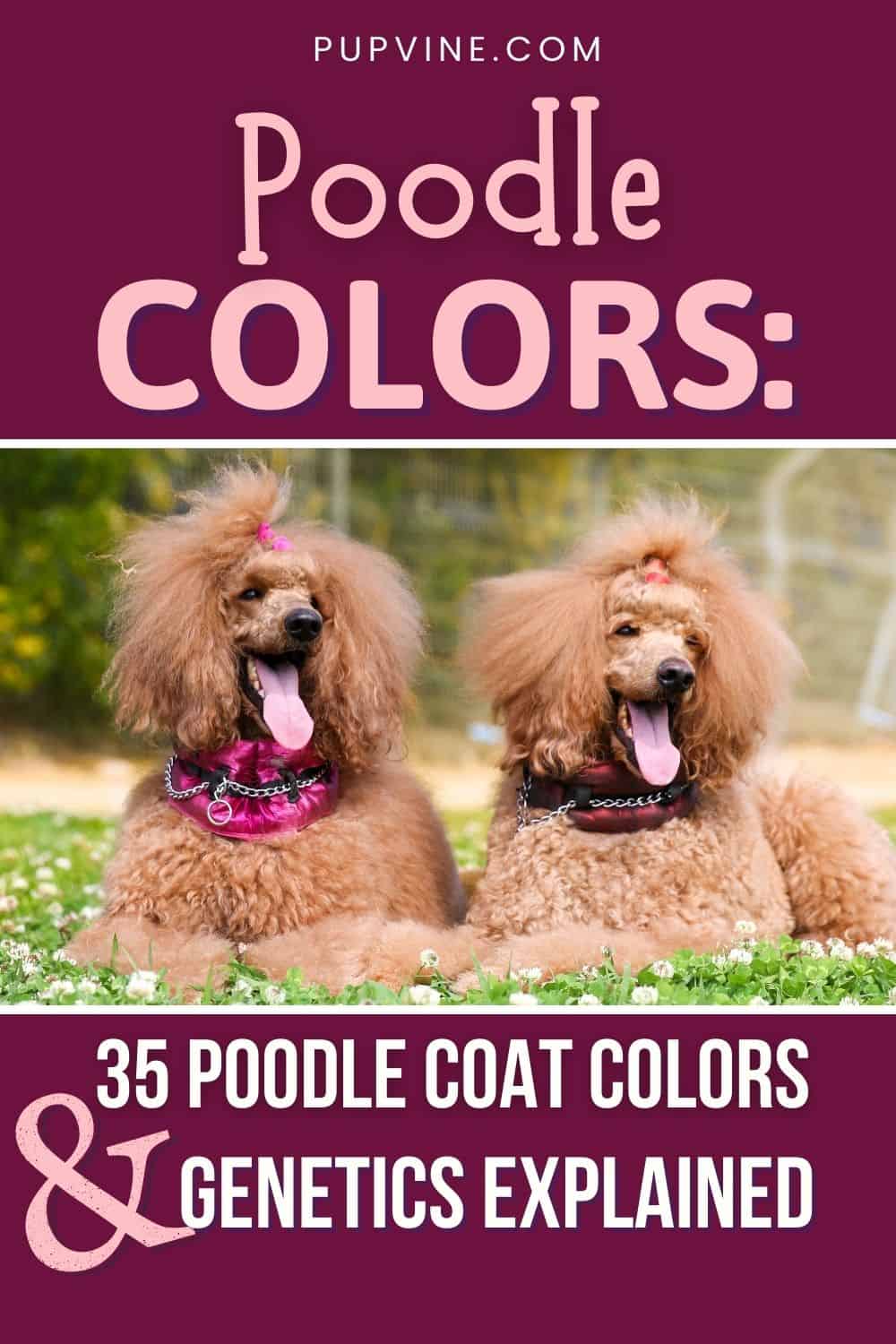Poodles are known to come in all shapes, sizes, and coat colors. No matter if you’re interested in a Toy Poodle, a Miniature Poodle, or a Standard Poodle, you’ll notice a huge variety of shades these doggies come in!
While there are many solid-colored Poodles, the true fun begins once you learn about the multi-colored Poodles and all the color combinations you can find in them!
We have compiled a list of 35 different Poodle colors just for the fun of it! And, to help you understand these fascinating dogs a bit better, we have also explained the genetics behind the dog’s coat color.
Let’s begin!
Poodle Color Genetics

The Poodle colors, just like everything else, are determined by the dog’s genetics. Each puppy inherits one color gene from each parent. In the end, the combination of these two genes is what you’ll see in a dog.
Usually, the dominant gene overcomes the recessive one. However, if you have two dominant or two recessive genes, the shade or the pattern might be the result of mixing these two genes.
Some genes are responsible for specific patterns or markings while others control how much pigment your dog’s fur will have. But, that’s not it – even if two dogs have the same combination of two color genes, they might still have slightly different patterns or shades.
This is because many things influence how the coat color will express itself. With colorful dog breeds such as Poodles, predicting the exact color and pattern is nearly impossible.
Do Poodle Colors Change Over Time?
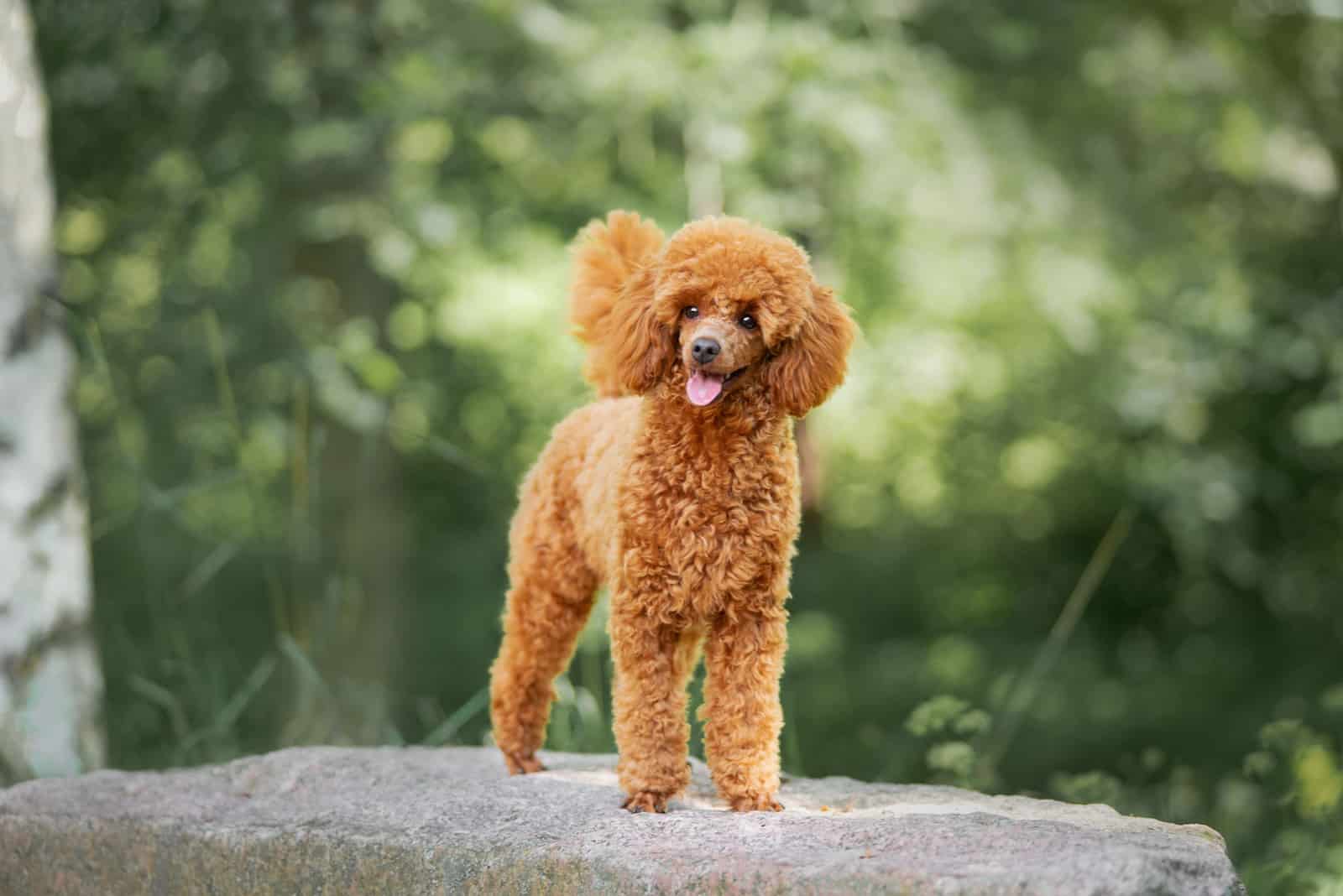
Another thing that can complicate your understanding of Poodle colors is the fact that the coat shade can change over time. In fact, most Poodle puppies will change color as they reach adulthood.
In the rare case that the Poodle puppy stays the same color throughout its life, this is a process called ‘holding’. On the other hand, when their coat colors change, this is called ‘clearing’. This usually means the Poodle color has lightened over time.
The clearing is usually uneven, and the entire coat won’t just become lighter altogether. Instead, it can affect certain parts of the body more, such as the ears, the muzzle, or a thicker guard.
Most notably, all gray Poodles are born black, but they become lighter over the years until they reach their true color by the time they are four years old. This progressive graying is quite common with the breed.
Similarly, cafe au lait Poodles are born brown, but become lighter during the next two years.
Different Poodle Colors
Most people imagine Poodles in solid-colored coats. This includes black, white, blue, brown, apricot, cream, red, silver, gray, cafe au lait, and a few more.
However, purebred Poodles can also come in plenty of multi-colored options. While various patterns are accepted by the Poodle breed standards, they are not allowed for the American Kennel Club (AKC) conformation show ring.
On the other hand, the United Kennel Club (UKC) allows parti Poodles to be a part of the dog shows, but they are not considered as desirable as solid-colored ones.
Without further ado, here are 35 Poodle colors that you have to know about:
1. Black Poodle

Black is the most common color in Poodles.
Solid-colored black Poodles are jet black in color. There are no hints of other colors. This isn’t limited to their coat color only. Instead, they’ll also have black noses, eye rims, and lips. They’ll also have dark brown to black eye color.
With true black Poodles, especially those that have a solid color, the fur should never fade to gray. Also, any white hairs are forbidden.
2. Apricot Poodle
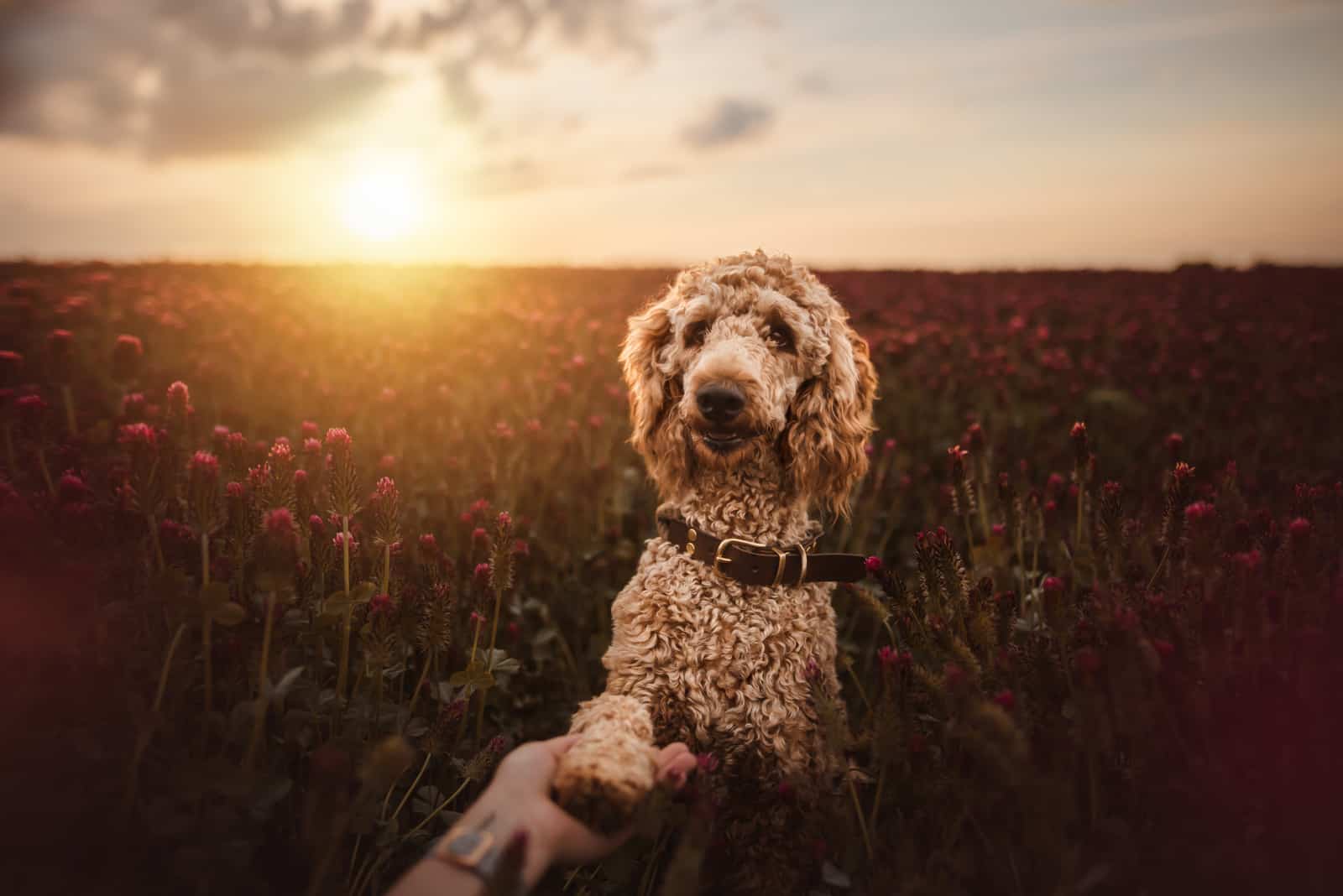
Apricot Poodles have a dull orange coat with medium saturation. This is a diluted shade of red Poodle color, so many people get the two confused. In fact, some dark apricot Poodles might appear red at first glance, but they still have the same dilution gene.
Also, certain apricot Poodles might be so light that they appear creme at first sight.
3. Brown Poodle

Photo from: @naofnaofnaof
A brown Poodle has a deep coat color, with liver points and light to dark amber eyes. True brown Poodles don’t have any black points on them, and this includes their nose and eyes as well. These have to stay brown.
A brown coat color might sometimes appear reddish or even ginger in sunlight, but they’ll always be brown in a different light.
The famous Winston Churchill’s Poodle, Rufus, was known for its chocolate brown coat.
4. Cream Poodle

Photo from: @cream_poodle_1003
Cream Poodles are such a light shade that they get confused with white-colored ones. Still, once you take a good look at these doggies, you’ll notice that they do have a cream shade to them.
These pups look similar to silver beige and cafe au lait Poodles, but there is one big difference: cream Poodles have a black nose and dark eyes. This is the biggest indication that your Poodle is cream instead of one of these two colors.
Also, most cream Poodles have black points on certain parts of their bodies. This is perfectly acceptable within the breed standard.
5. Gray Poodle
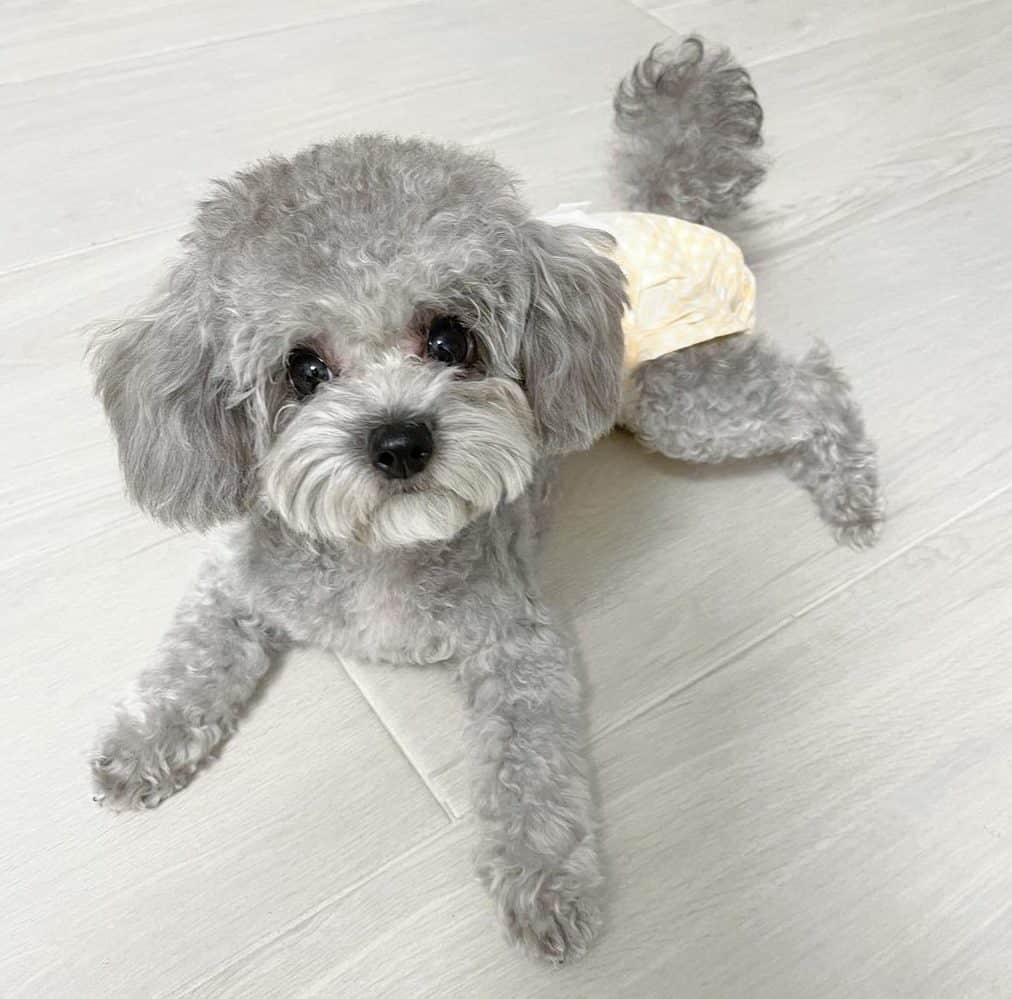
Photo from: pipi.greypoodle
Gray Poodles are visibly lighter than blue ones. Instead of having the graphite shade, they tend to have such a grey shade that makes them look almost old.
Some gray Poodles were born black, but they turned gray over time. Others were already born gray, but most will turn lighter as the years go by.
6. Blue Poodle
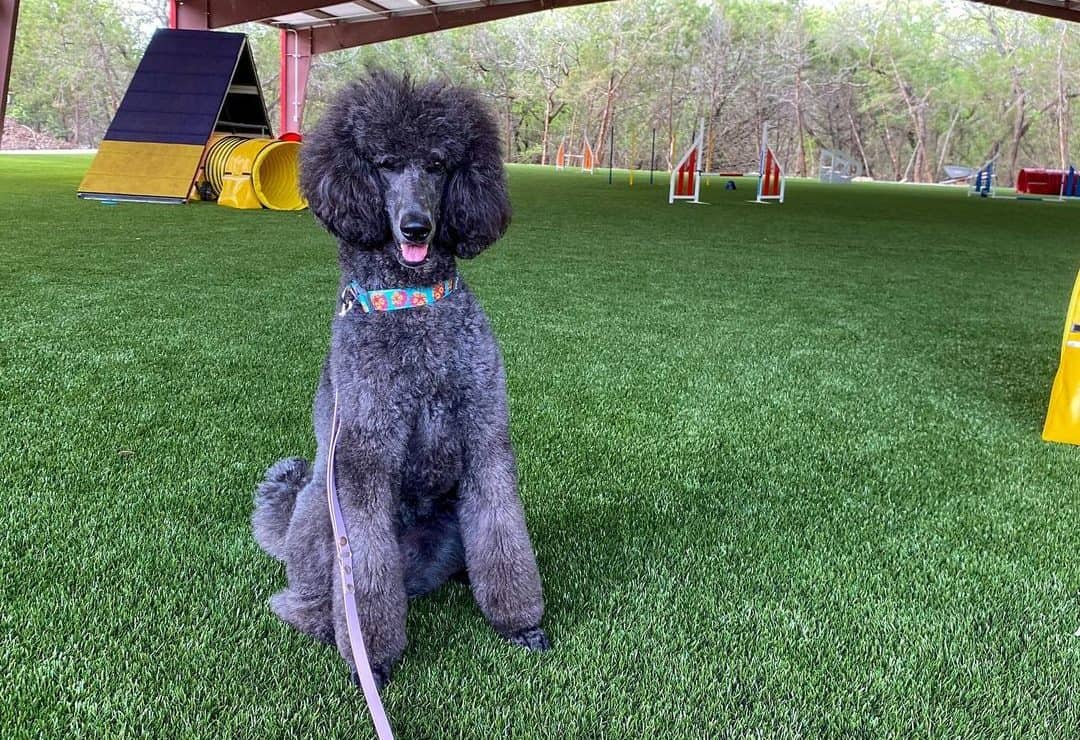
Photo from: @servicepoodlenellie
Blue coat color is, in fact, a dilute black tone that appears charcoal gray in shade. All blue Poodles are born black, but they lighten over time. Most will reach their true color in the first few years, but others might experience a constant change in shade until they are four years old.
Most blue Poodles keep the black outer coat, so some dog owners mistake them for black Poodles. Still, blue Poodles have lighter roots, and most will have blue noses, lips, and eye rims.
7. Silver Poodle
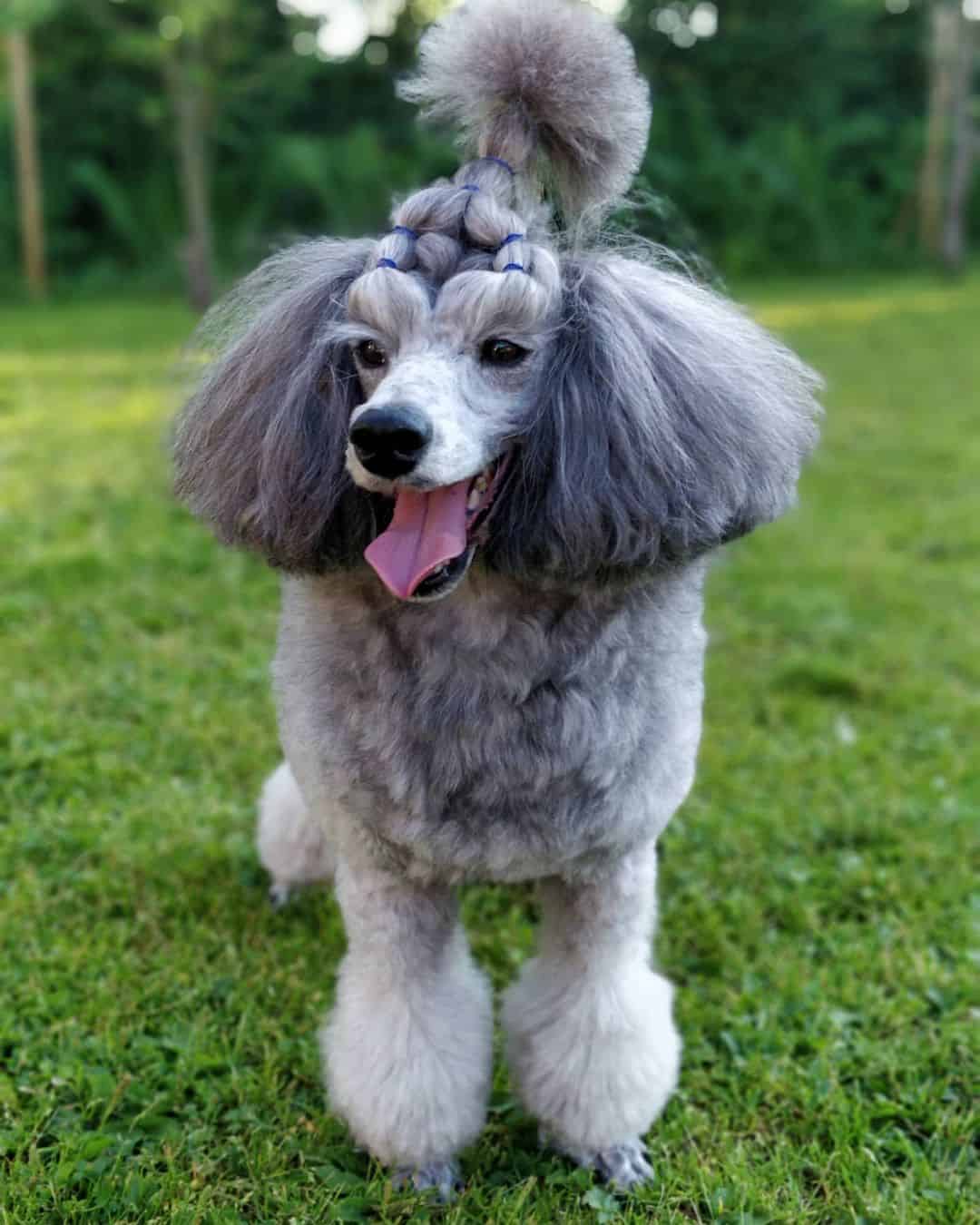
Photo from: @silverpoodleboys
Silver coat color is another dilution of black. They are similar to gray ones because they were born black, but they become lighter over time. In fact, by the time they are six weeks old, silver Poodle puppies should already have silver faces and feet.
The shades of silver Poodles can vary anywhere between a pewter color and platinum. They’ll remain fairly lighter than gray and blue Poodles, and they’ll have a black nose, dark eyes, and even certain black points.
8. Red Poodle
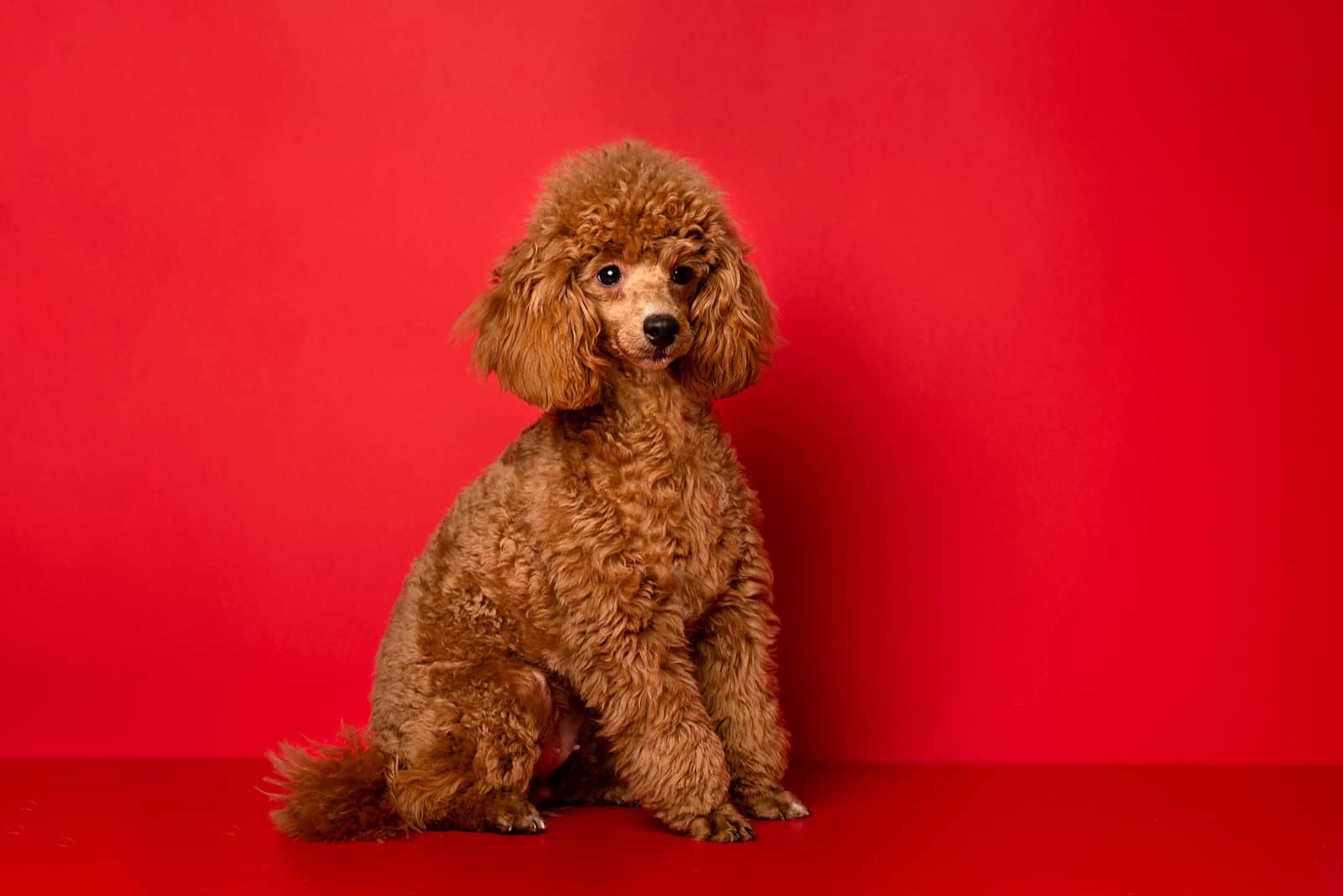
Red is a fairly new Poodle color as it wasn’t recognized until 1980. This makes it somewhat rare, yet quite desirable.
Many red Poodles look very similar to apricot ones. Others tend to have a dark mahogany coat. Unlike brown Poodles, they’ll have a black nose and dark eyes.
9. White Poodle
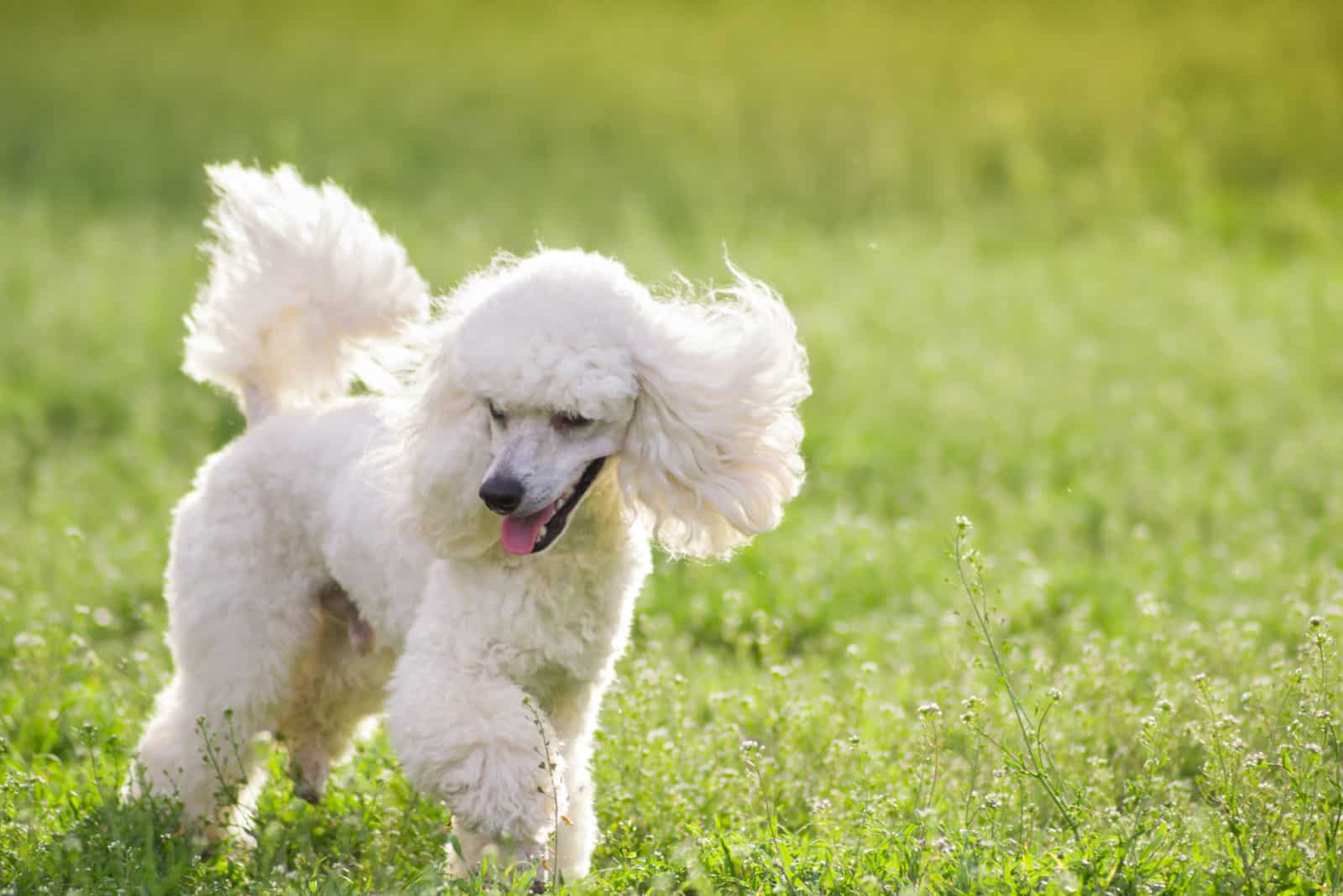
White Poodles can have either a warm or a cold tint, but they’ll always look pure white. Many are born with beige- or apricot-tinted ears, but this is accepted by the breed standard.
They can have black points on their coats, but not black spots or anything that makes them appear dirty. Also, they have black noses and dark eyes.
10. Silver Beige Poodle
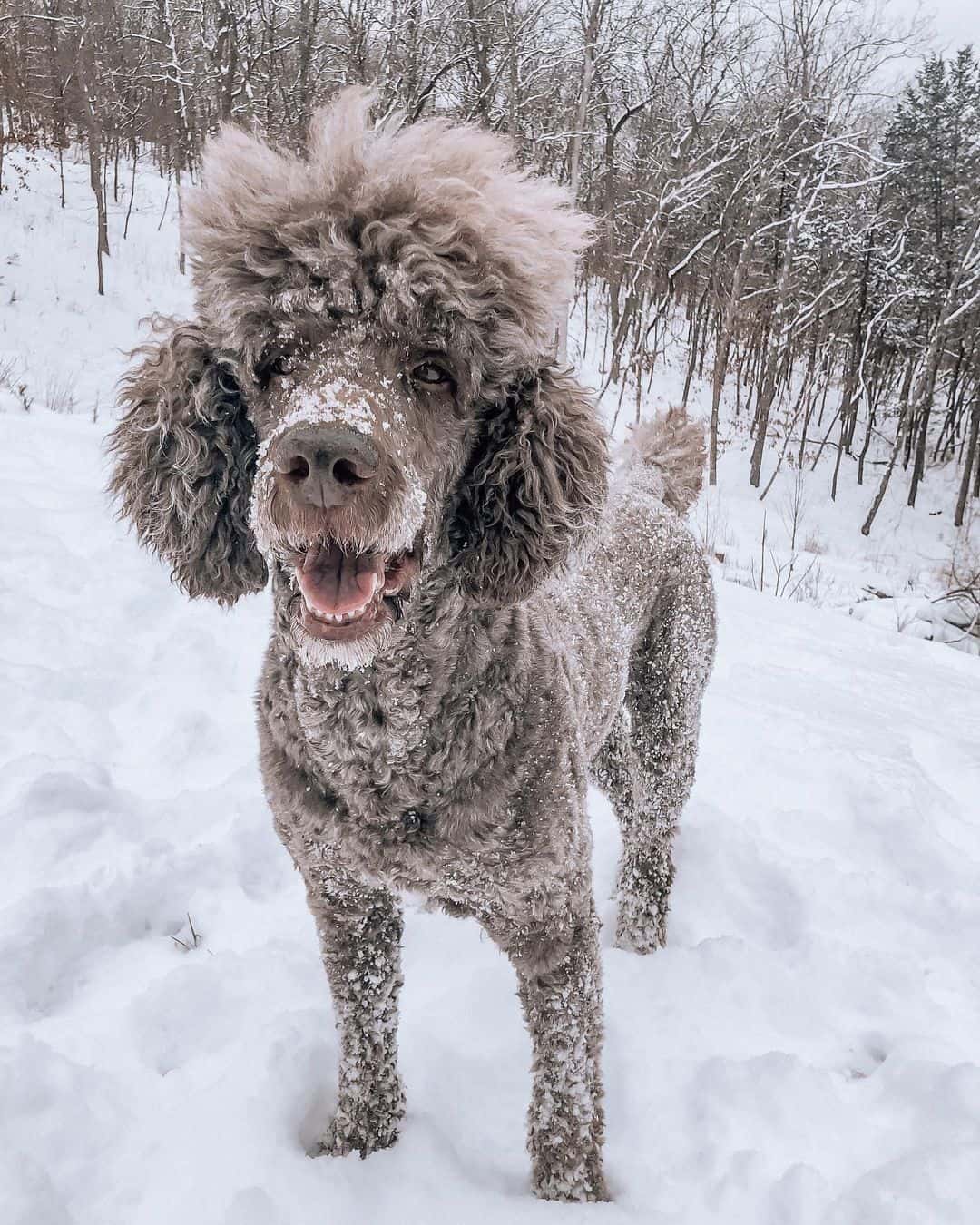
Photo from: @mskearby
Silver Beige Poodles look just like brown Poodles when they are born. However, they turn silver over time. Just like silver Poodles, they should already have clear silver markings by the time they are six weeks old.
Most of these pups will appear silver, but with a slight brown tint to them. Also, their noses will be brown instead of black, and their eyes can be a lighter shade of brown.
11. Cafe Au Lait Poodle

Photo from: @amber.andher.standards
This Poodle color looks a lot like silver beige because it’s also a silverish color with a brown tint. However, its coat is very shiny while silver beige Poodles have a duller shade.
Similar to silver beige Poodles, these dogs also have brown noses and amber eyes. However, they can also have liver points.
12. Black And Cream Poodle
Black and cream Poodles have a black base color with light to medium yellow markings. Just like standard black Poodles, they have a black nose and dark eyes.
Keep in mind that the majority of their coat has to stay black while the cream markings only take up a small portion of their coat.
13. Black And Apricot Poodle
These Poodles have a black base coat and apricot markings on their body. The exact shade of the markings can vary. Some might appear dull orange while others might be much lighter.
14. Black And Brown Poodle
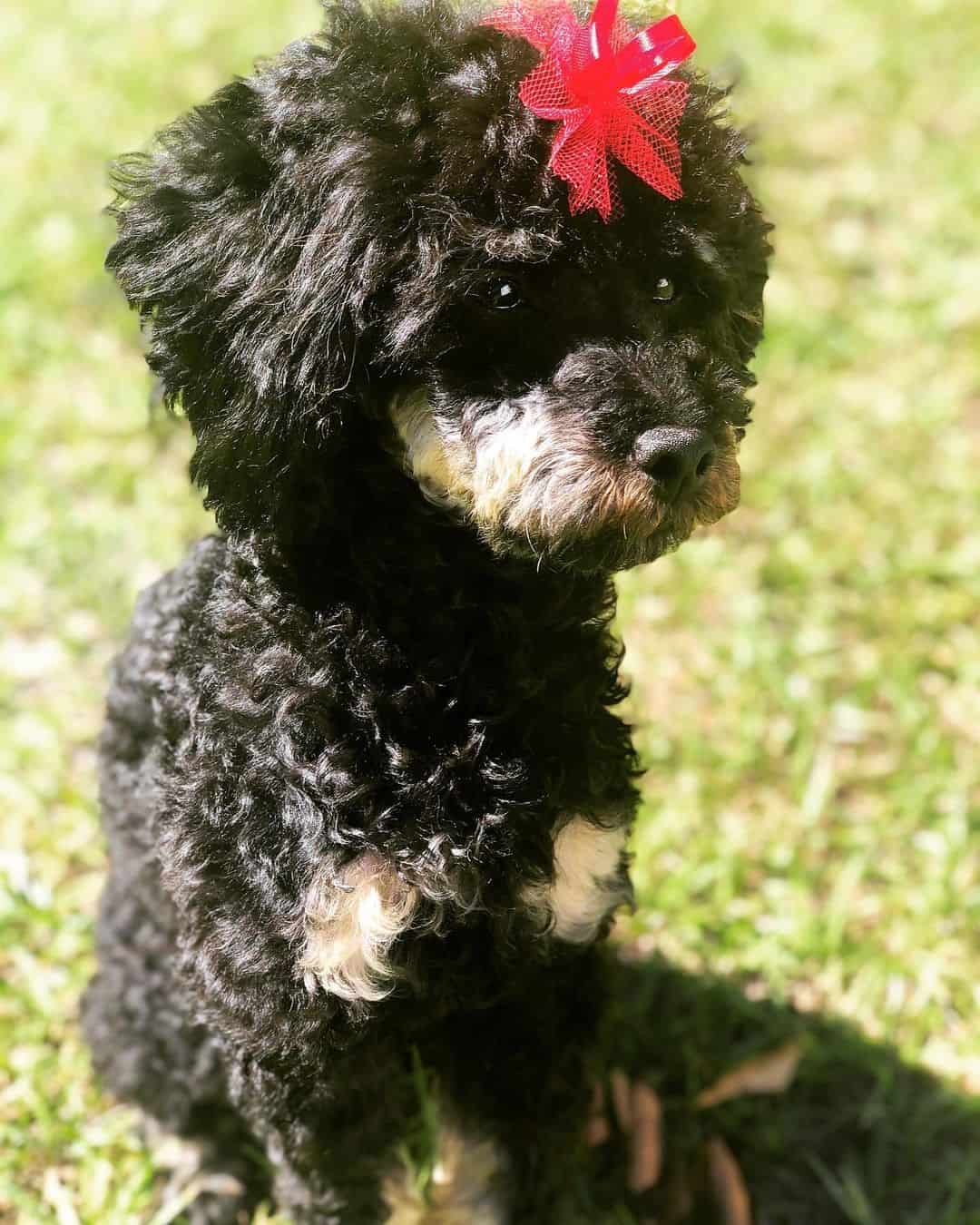
Photo from: @gigi_gianna_thetoypoodle
Black and brown Poodles might, at first glance, look just like solid black ones. This is because they have two different colors that are both very dark, so it might not be easy to spot the two shades.
Overall, their base is black and their markings are chocolate to brown. Since black is the main color, their noses and eyes will remain dark.
15. Black And Gray Poodle
These Poodles have a rich black base color with light gray markings. In fact, some of these markings might even be light blue in shade – but not so light that it appears silver.
These pups possess a dilution gene that only affects portions of their fur, giving them a specific gray pattern.
16. Black And Red Poodle
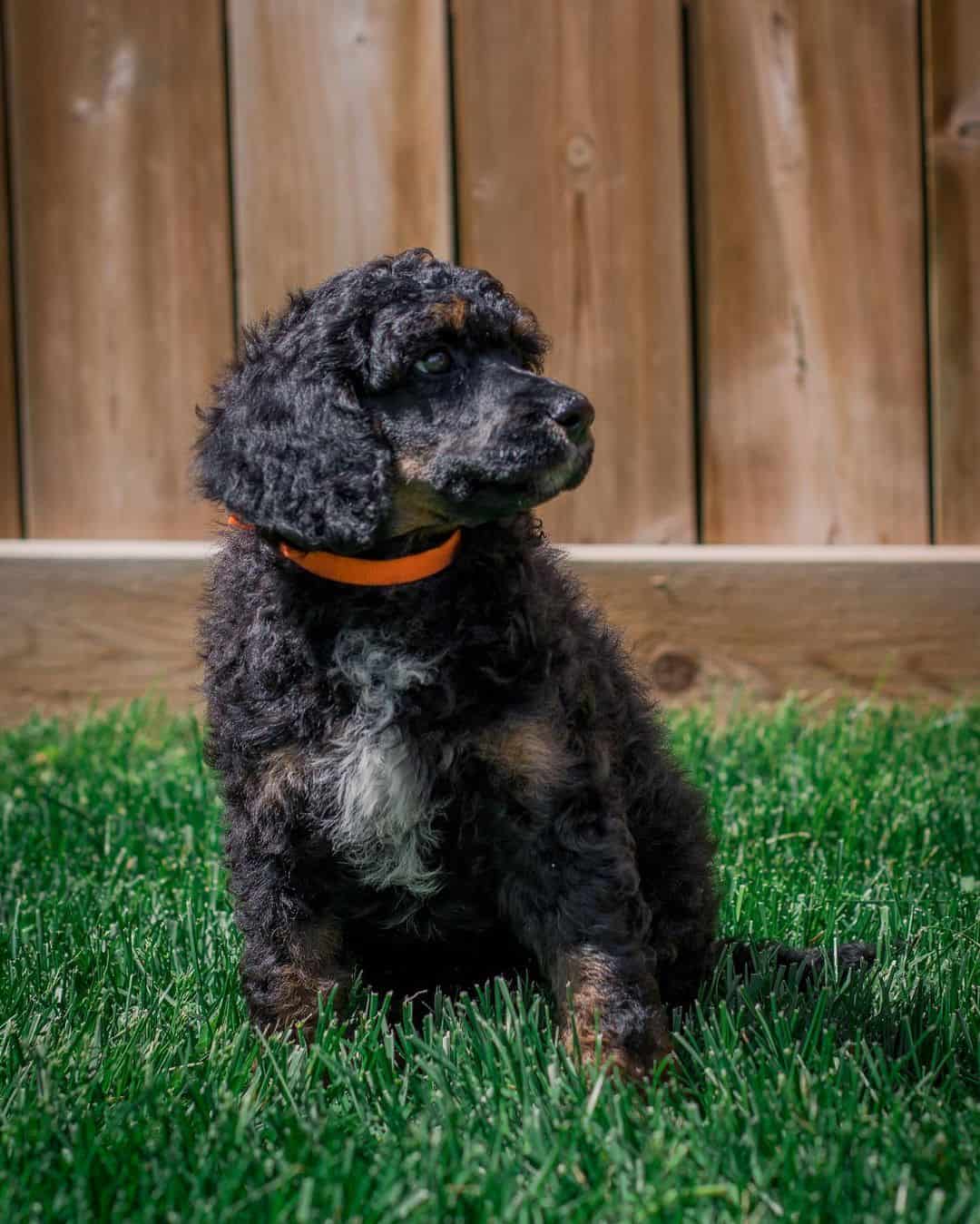
Photo from: @raising_the_standard_poodles
Black and red Poodles have a unique combination of shades on them. They sport a jet black base, and a smaller portion of their body is in various red varieties that could range anywhere between ginger and chestnut to mahogany.
17. Black And Tan Poodle
The tan color is a specific variation of a red shade, which is caused by combining the pheomelanin with a dilution gene. These pups have a pitch-black base color and tanned markings that might appear as being light brown under darker lights.
18. Black And Silver Poodle
Unlike black and gray Poodles, which possess dark charcoal markings, these dogs have a light gray tint that is usually located on their face, chest, and feet.
19. Black And White Poodle

Photo from: @peppertree.ranch.poodles
Some dog lovers confuse black and white Poodles with parti Poodles, although the genetics behind these two patterns are entirely different. Also, black and white Poodles commonly come with tuxedo patterns.
Black and white Poodles have a black base coat and white markings that make them look like some cross breed. Don’t let this fool you – they are purebred.
20. Blue And White Poodle
This is one of the most unique Poodle colors. They have a blue/dark gray base coat with white markings. This is a rather aesthetically pleasing color combination, making it one of the more popular options among aspiring Poodle owners.
These Poodles are usually born black, but then their color changes to blue and they get their noticeable white markings. Also, they have a black nose, eye rims, and foot pads.
21. Brown And Apricot Poodle
These Poodles have a brown base that might be mistaken for red in the sunlight. At the same time, they have lighter, medium-saturated orange markings on their body, usually on their muzzle, chest, and legs.
22. Brown And White Poodle
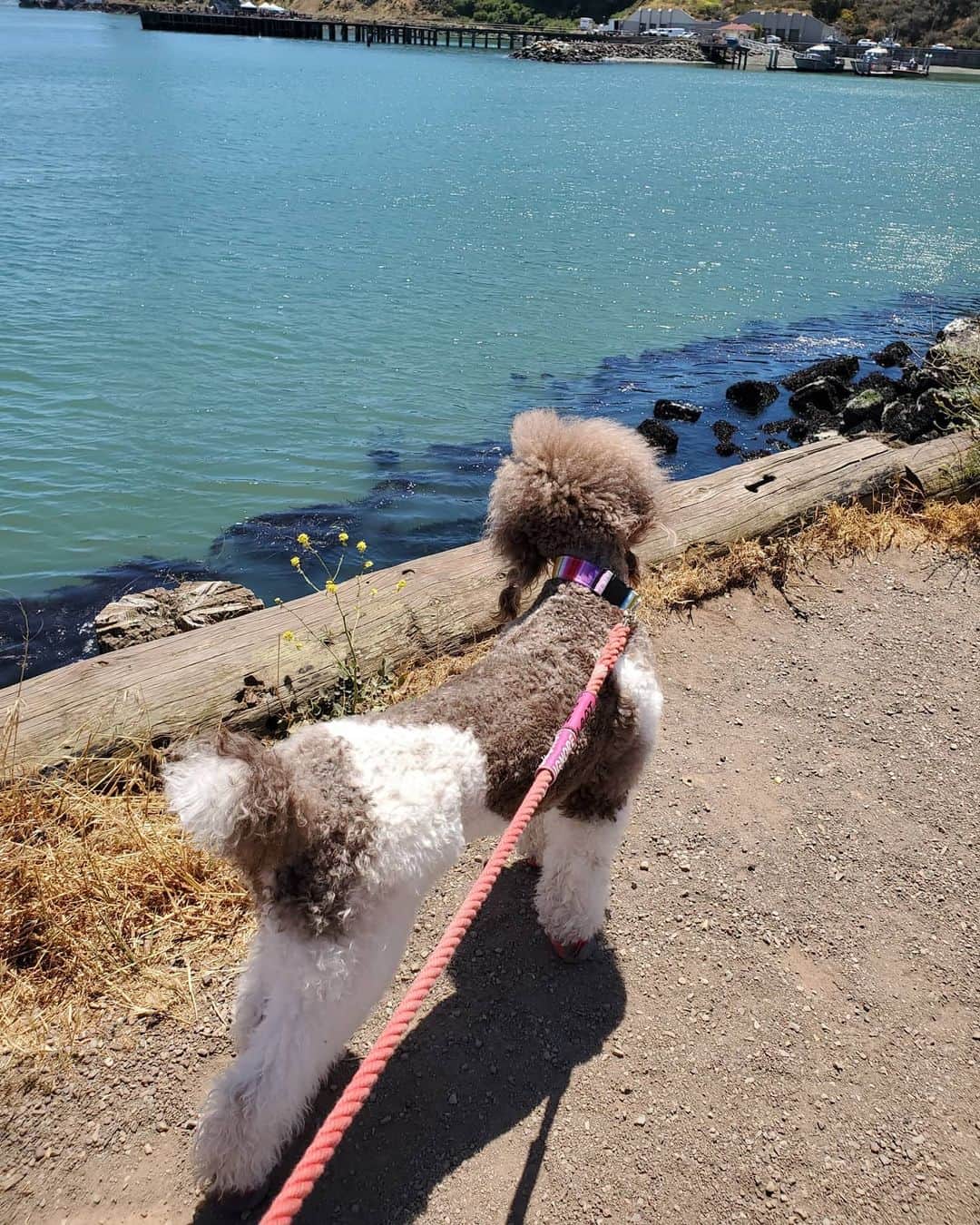
Photo from: @queenpearlharbor
Just like brown and apricot Poodles, these Poodles have a brown base coat. However, their markings are pure white instead of a light orange color.
23. Cream And White Poodle
This Poodle combines two of the lightest colors this dog breed can come in. They are cream to slightly yellow in color, with white markings on them.
A cream and white Poodle should always have more cream than white on its coat.
24. Gray And White Poodle
These Poodles are similar to blue and white ones, but their base coat color is much lighter. Some might even look like they are graying, even if they are very young.
The white markings can occasionally have a slight yellow tint to them.
25. Red And White Poodle
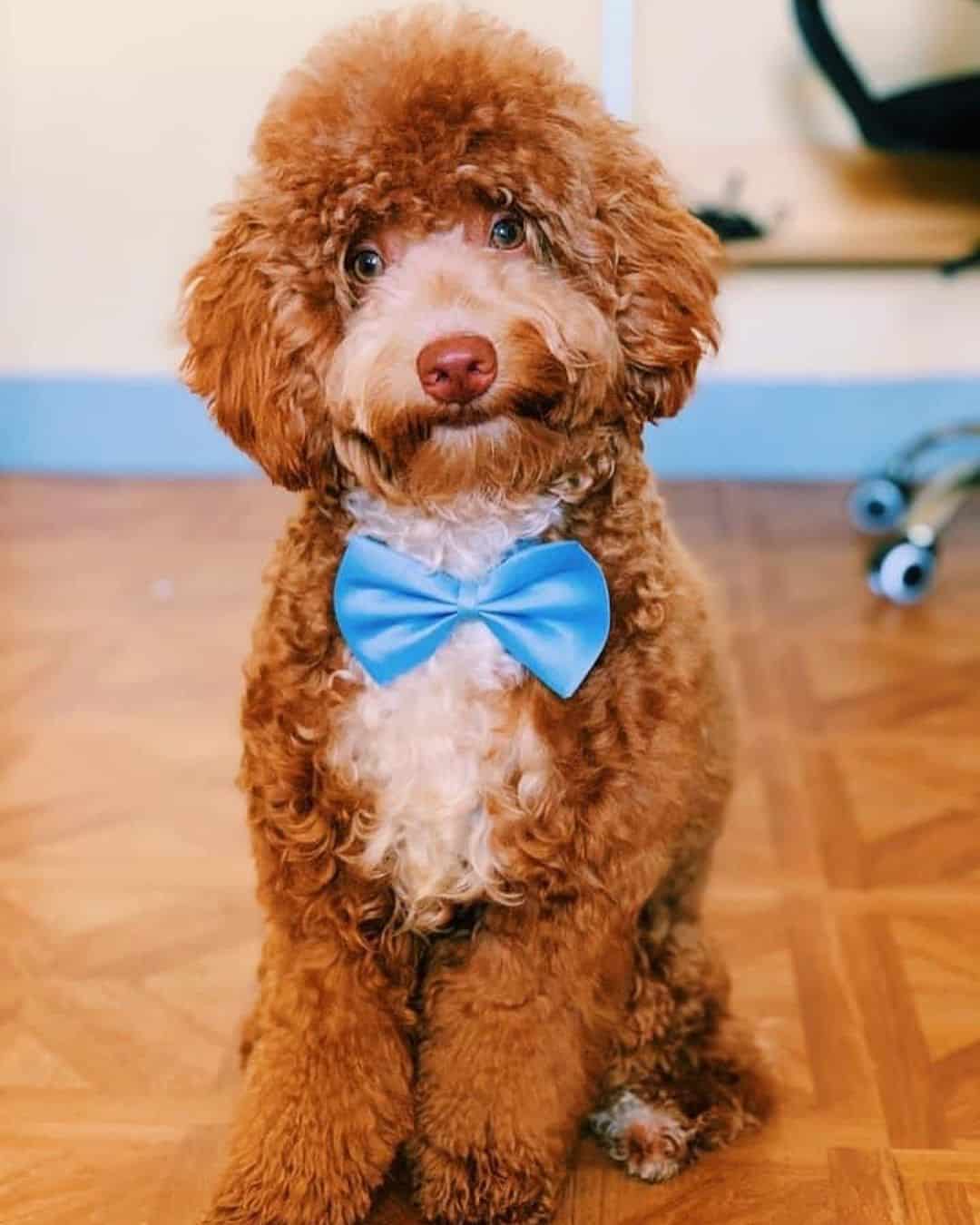
Photo from: @summer_xiayin
Red and white Poodles, like their name suggests, have a red base coat and white markings on parts of their body. The biggest part of their body will remain red.
The shade of red can vary from mahogany to apricot, but keep in mind that all of these dogs will be considered red and white, and not some other color combination.
26. Red And Apricot Poodle
These Poodles might appear solid-colored at first as red and apricot are very similar shades. However, if you look at these dogs closely, you’ll notice that they usually have a darker red base with medium to light orange markings.
27. White And Apricot Poodle
White and apricot Poodles can look like inverted apricot and white Poodles. Their base color is white, and they have apricot markings that are usually located on their ears, back, and sometimes legs.
28. White And Silver Poodle
White and silver Poodles have a white base color and shiny, light gray or even platinum markings on various areas of their body. These markings are usually located on their face and chest.
The nose and eye color of white and silver Poodles will always be black.
29. Parti-Colored Poodle
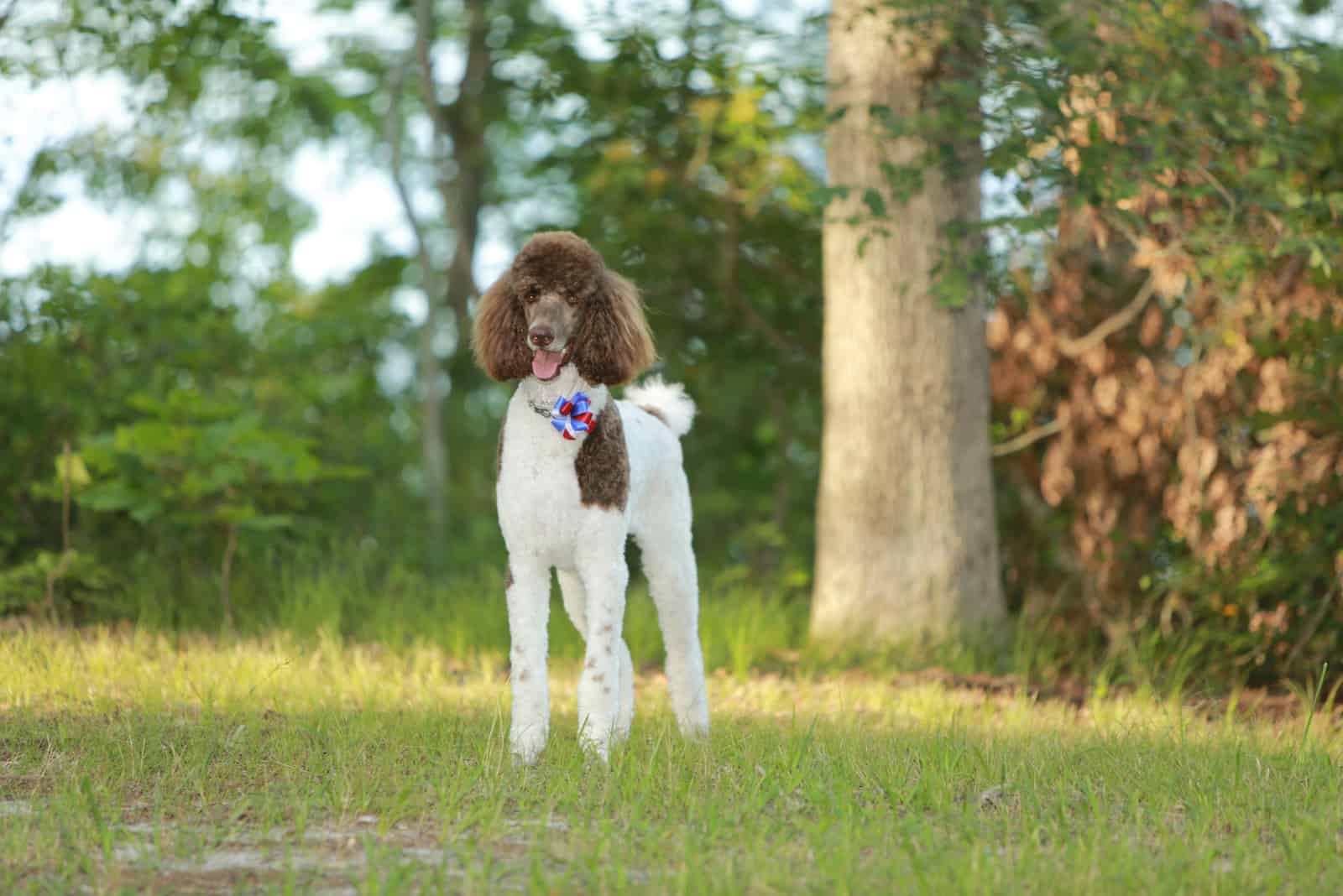
A parti-colored Poodle has a white base and irregular patches of some other color on their body. They are sometimes known as 50% white Poodles.
While you can register your parti Poodle with the AKC, you won’t be able to participate in dog shows as this color is considered faulty.
30. Phantom Poodle
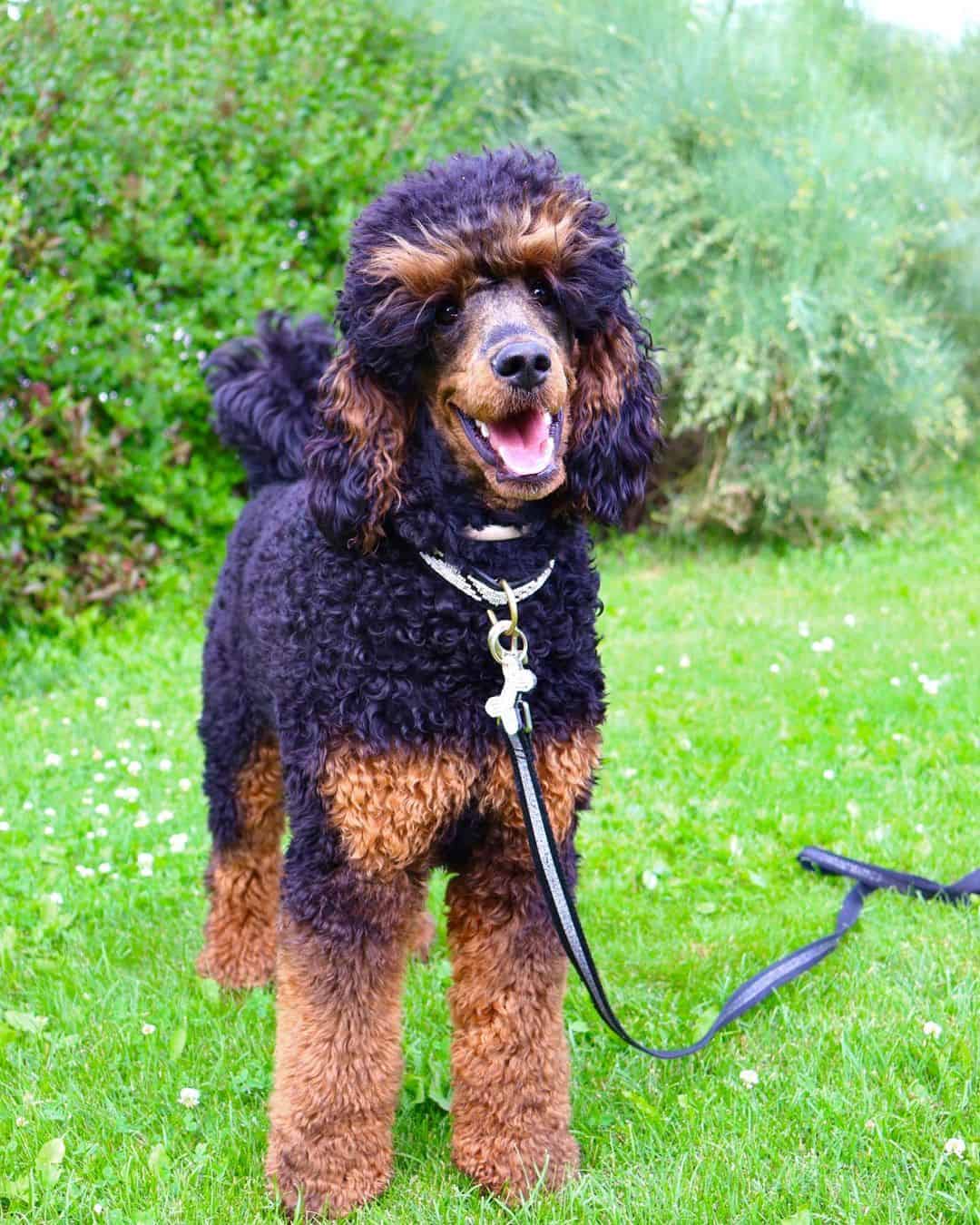
Photo from: @saga_norwegianfloof
The phantom Poodle is one of the rarest patterns in this dog breed Also, they are sometimes mixed with parti Poodles as they have two colors on their coat. They usually come in blue and white, but this isn’t mandatory, and these doggies can come in any two standard colors.
The biggest difference between a phantom Poodle and a parti Poodle is in the placement of the markings. The markings have to be located on the dogs’ muzzle, chin, eyebrows, throat, legs, paws, and under the tail.
31. Merle Poodle
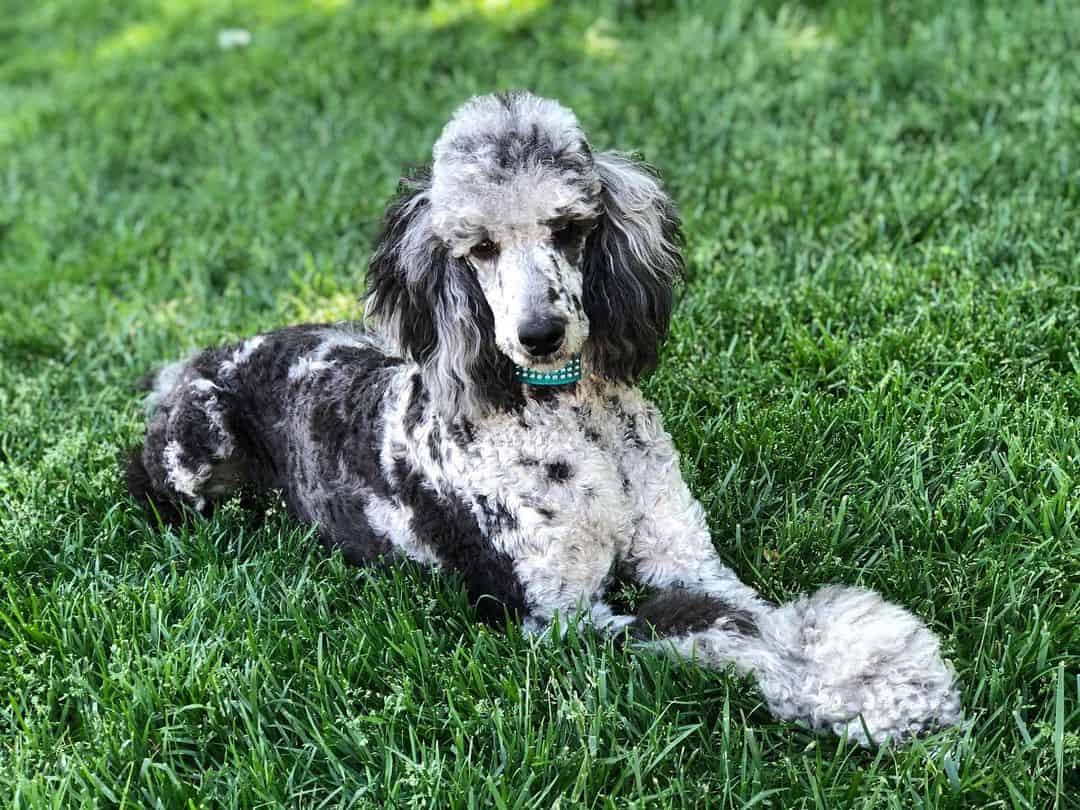
Photo from: @elizabethnchasepoodles
Merle isn’t a natural color for Poodles. It usually comes by introducing the gene via mixing some other dog breed with a Poodle, then spreading it through generations.
Merle Poodles have a specific pattern. They have a white base coat with mottled patches of any other two colors acceptable for the breed.
Keep in mind that the merle pattern is quite frowned upon by most reputable breeders. This is because the merle gene is linked to many health problems in dogs such as deafness, blindness, kidney diseases, cardiovascular issues, and so on.
32. Sable Poodle
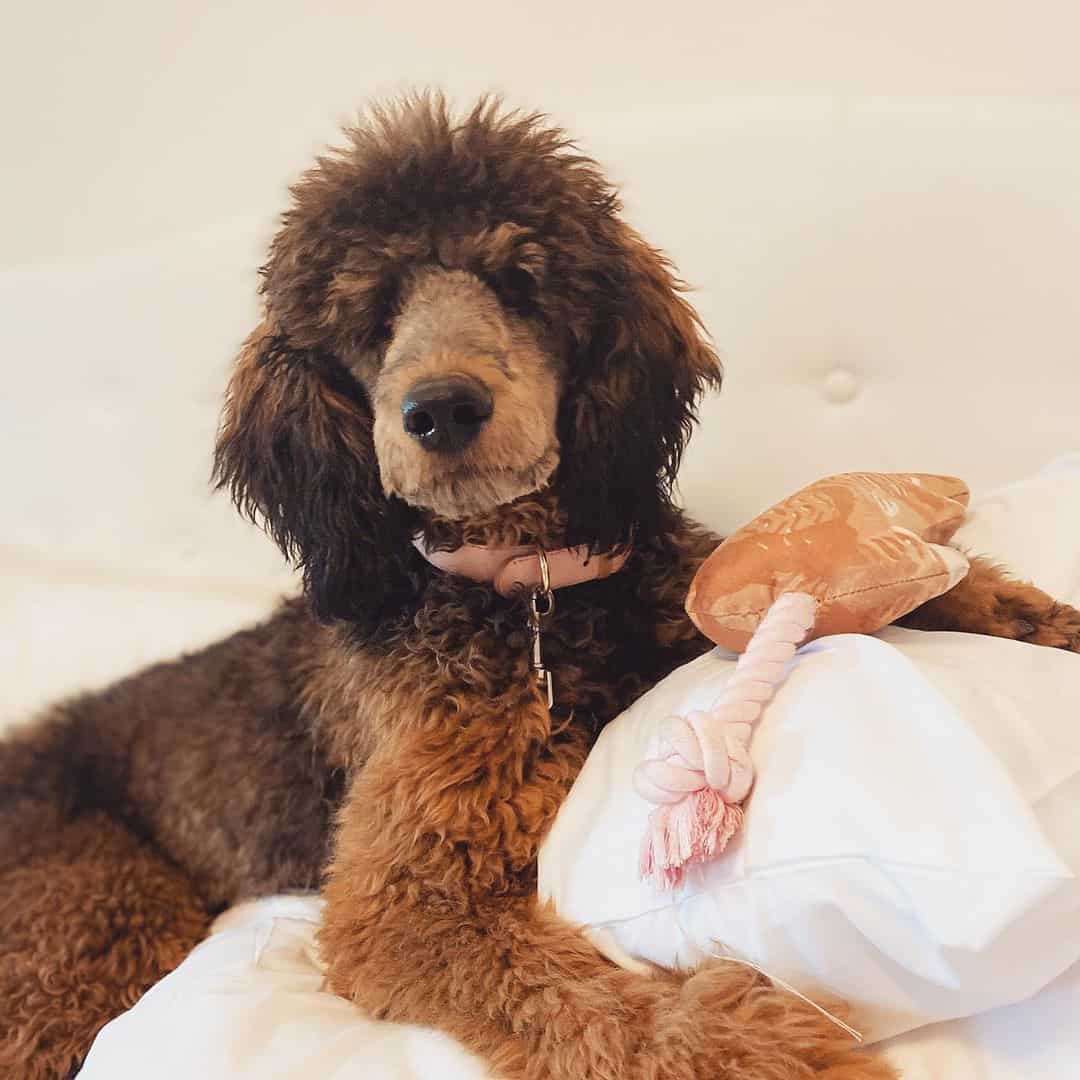
Photo from: @peak.and.me
Sable Poodles have a solid-colored base coat that can be in any standard color. However, the hair tips are black, giving the dog a very unique appearance.
When born, these puppies can look entirely black. However, as they grow older, the lower part of their hair turns lighter while the tips remain black. As the dog grows older, the black tips that are typical for sable color will fade away.
33. Brindle Poodle
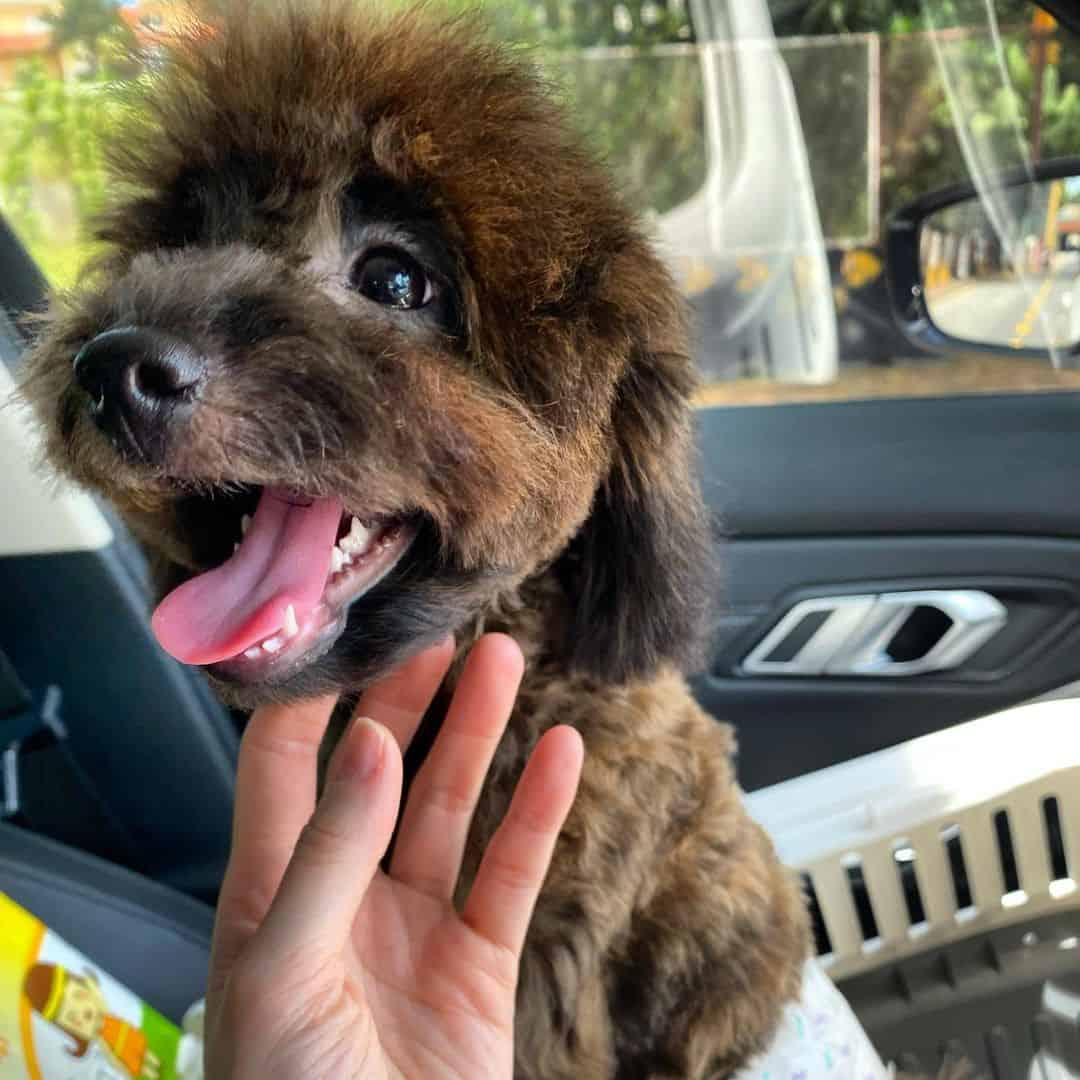
Photo from: @thepoodle_oreo
Brindle Poodles are among the rarest in the breed. This is because the brindle pattern is the result of two recessive genes, meaning the puppy has to inherit it from both of its parents.
Brindle dogs have a striped pattern that might resemble a tiger’s coat. While the stripes are usually black or dark brown, the base color can be any of the standard Poodle colors.
Poodles in this color cannot participate in dog shows, and not all kennel clubs will even allow you to register them.
34. Tri-Color Poodles
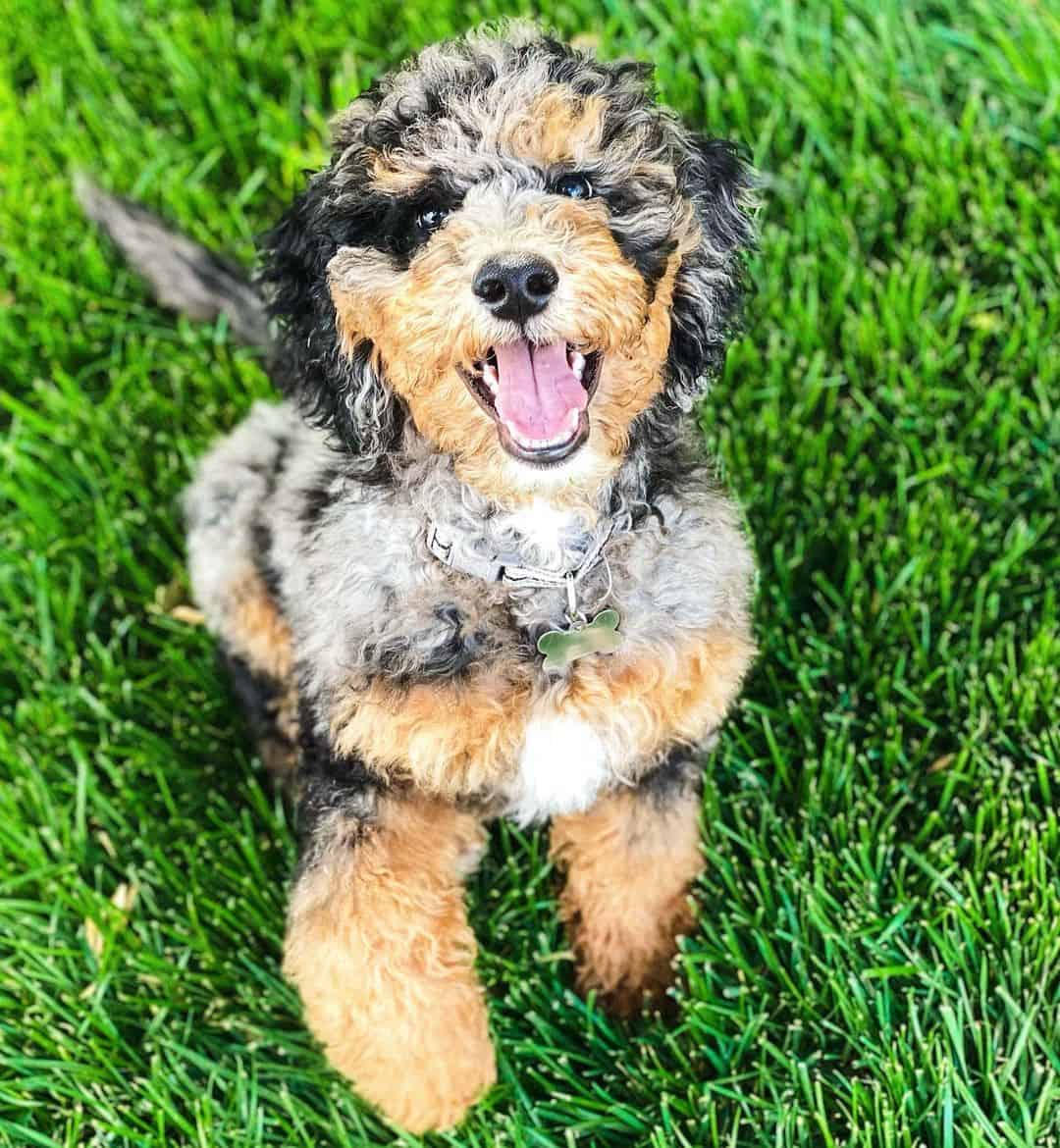
Photo from: @kbranddoodles
Genetically, tri-color Poodles are Poodles with two color patterns. Usually, they’ll combine parti Poodles with phantom markings.
The base color will usually be the darkest one. Then, you usually have white markings on the dog’s chest and legs. Finally, the third color can be seen on the muzzle and eyebrows.
This isn’t the only pattern combination in tri-color Poodles. For example, you might have parti colored Poodles with a brindle tuxedo or phantom Poodles with brindle markings. Not to mention the possibility of sable and brindle combinations!
Your tri-color Poodle might also have a black mask, which is considered extremely rare.
At the same time, tri-colored dogs can also experience a change in colors, just like any other Poodle. This can leave you confused, especially if this causes the entire pattern to change. Some tri-colored Poodles might end up resembling bi-colored dogs once they are older.
35. Albino Poodle
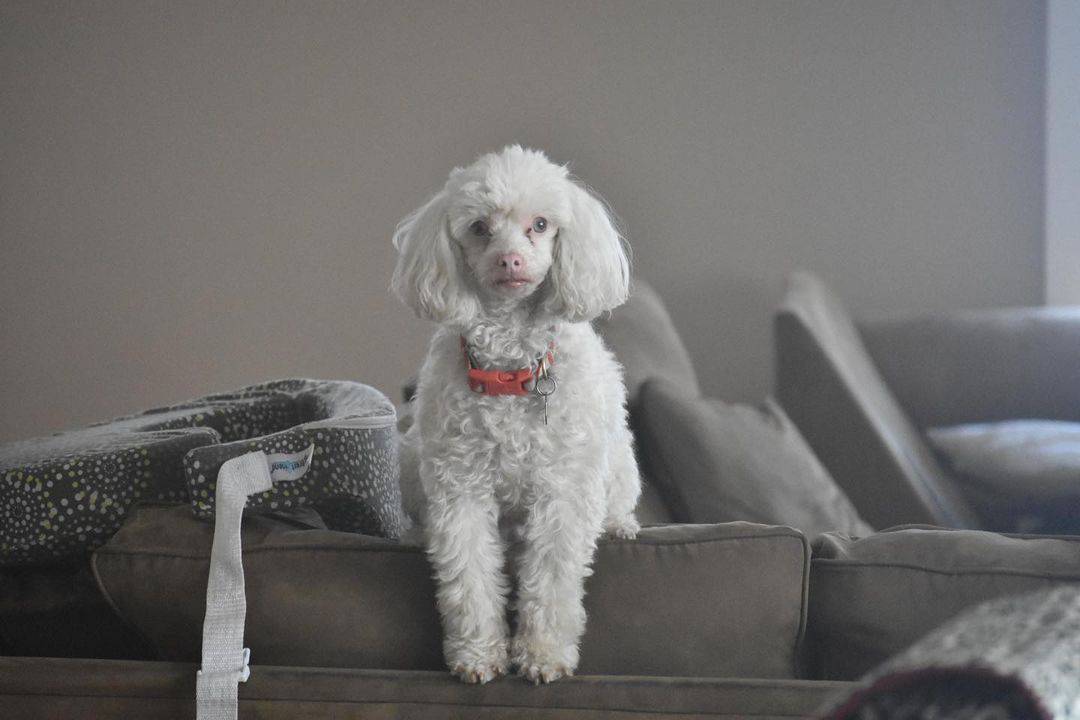
Photo from: @boo_and_tiger
While albino is not a true coat color but a genetic health condition, the dog’s fur shade can still help you learn whether your pooch suffers from albinism or not.
Albino Poodles might look like white Poodles at first glance. However, their coat isn’t truly white in color. In fact, it is devoid of any colors, making it appear white. These puppies cannot have any shade in their fur; it is entirely snow-white.
Also, unlike white Poodles that have a black nose, albino Poodles have a pink nose and pink eye rims. Their eyes can also be pink to red in shade, or even bright blue.
Similar to merle Poodles, people are also discouraged from buying albino Poodles due to the variety of health issues they can have.
Does Coat Color Affect Health And Behavior?
While not much research has been conducted on this topic, so far, there is no indication that the coat color has any effect on the behavior of your Poodle. All Poodle colors are equal in behavior, and everything comes down to the individual dog and how you train and socialize it.
However, when it comes to health, some coat colors are linked to several diseases. This most notably includes the merle pattern, but there are some reasons to suspect that brown dogs also have more health issues than dogs in other colors.
Some health conditions connected with the coat color include:
Deafness
Many merle, chocolate, parti, and albino Poodles have higher chances of deafness. For merles and albinos, this is because the loss of pigmentation also affects the cells inside the dog’s ear, damaging them.
This type of deafness isn’t acquired. The dogs will either be born deaf or won’t ever go deaf – unless they get some disease that isn’t related to the coat color.
Blindness And Eye Conditions
Unfortunately, blindness and sight problems are tightly connected with albinism as this condition affects eye pigmentation as well.
Most albino Poodles have clouded vision that can progress to blindness no matter how well you take care of your pooch. Many are born entirely blind. Almost all albinos have some sort of eye illness, such as abnormally small eyes and deformities of the lens, iris, and sclera.
On the other hand, conjunctivitis is somewhat common in parti Poodles. These dogs can often be seen with pus or mucus on one or both of their eyes.
Sun Sensitivity
Both the albino and the merle Poodle are sensitive to UV rays because they don’t have enough melanin to protect them from the sun. They are prone to solar dermatitis, especially when exposed to too much sunlight.
Skin Cancer
Unfortunately, albinos and merles are very prone to skin cancer. This is likely the worst thing that can happen, and it’s connected with their sun sensitivity.
These Poodle colors can get any type of skin cancer, including malignant melanoma, mast cell tumors, and squamous cell carcinoma. Some of these cancers are curable, but many are not. This is why it’s essential that your merle or albino Poodle never misses its vet visit.
Final Thoughts
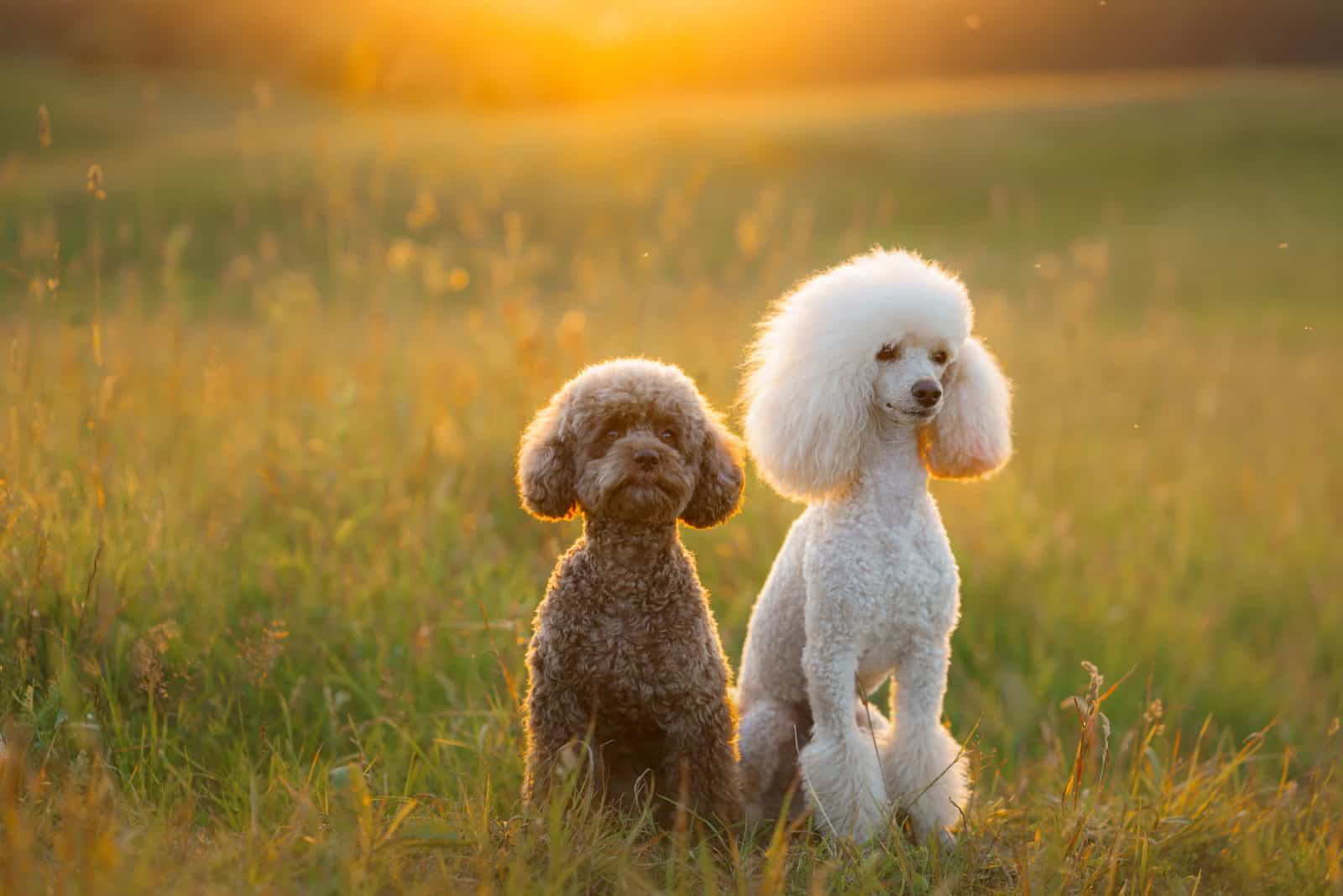
As you can see, Poodles can come in 35 or more coat colors. This leaves you with a big choice when it comes to picking the best Poodle color for you.
No matter the color you choose, the coat type will stay the same. Poodles have a curly coat that doesn’t shed as the loose hairs stay tangled.
While this means more groomer visits, it also makes them hypoallergenic, which makes them favorable among people suffering from dog allergies. In fact, their coat will shed significantly less than coats of some shorter-haired breeds, such as Labrador Retrievers or Dobermans.
This alone should be more important than the color of the dog. Still, if you have some preferences, go for it! All dogs are equally good, and with such a colorful breed, there is no reason why you shouldn’t pick one that you’d like the best.
Just keep in mind to always find an ethical breeder, especially if you choose some of the Poodle colors that can be connected with health issues.
Read Next: The Complete Guide To The Bloodhound Colors And Patterns
